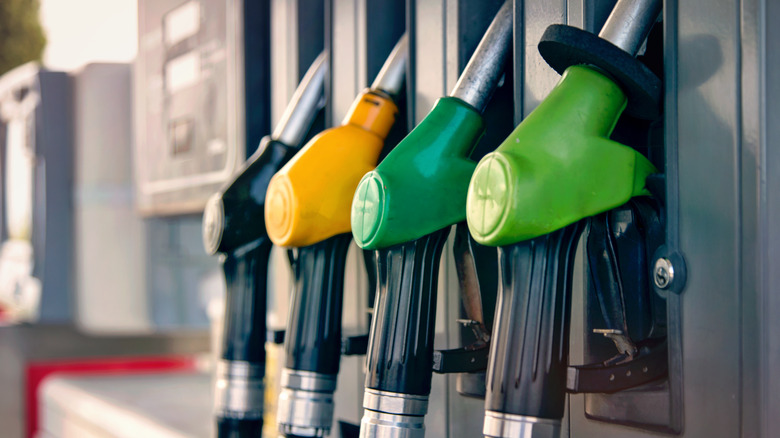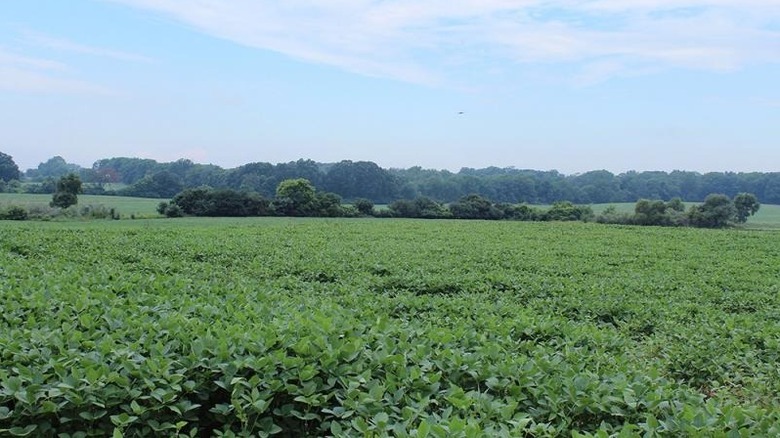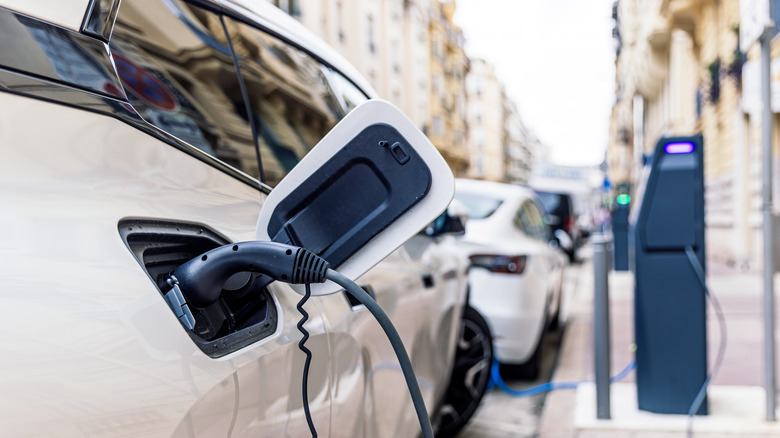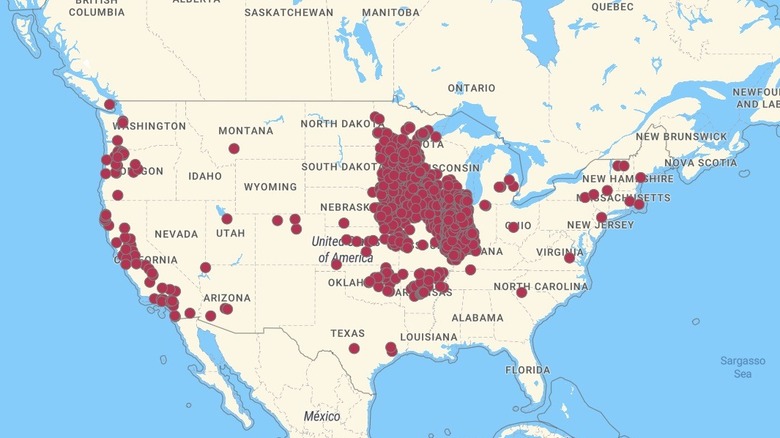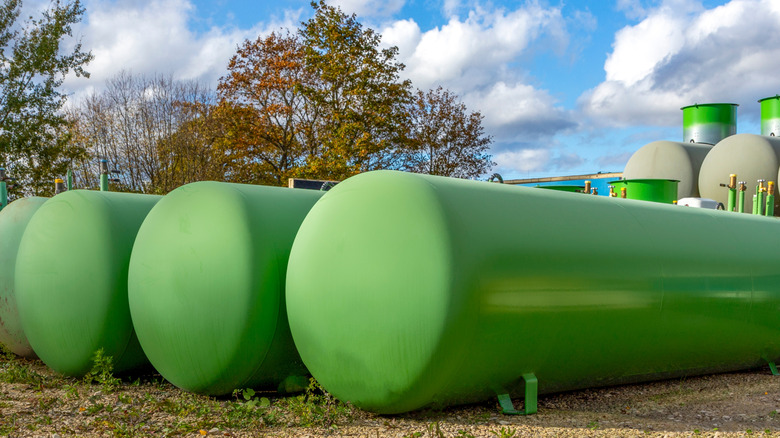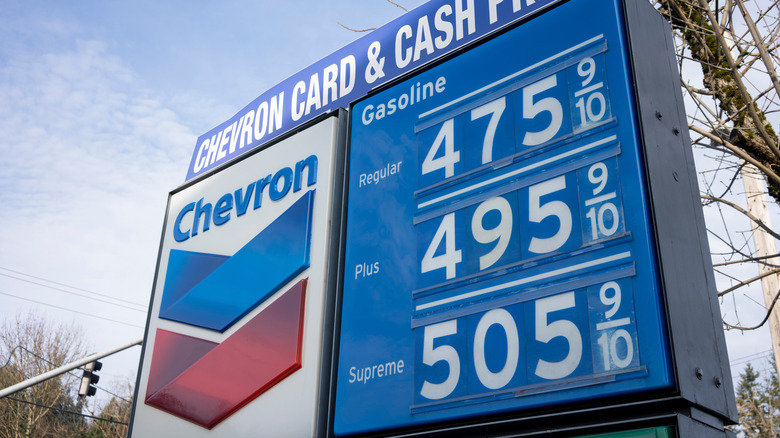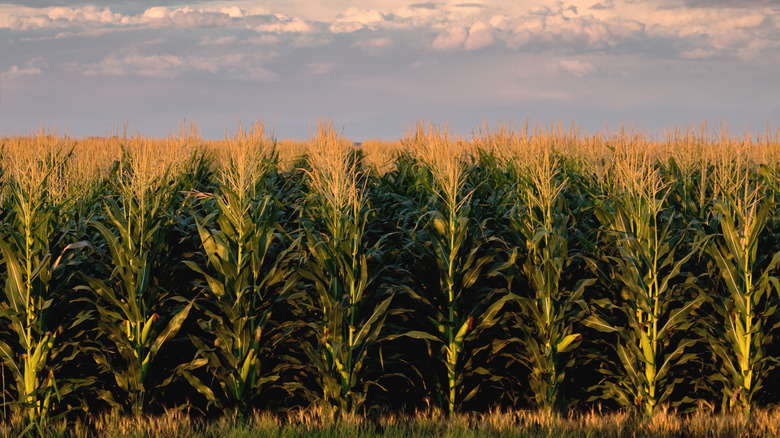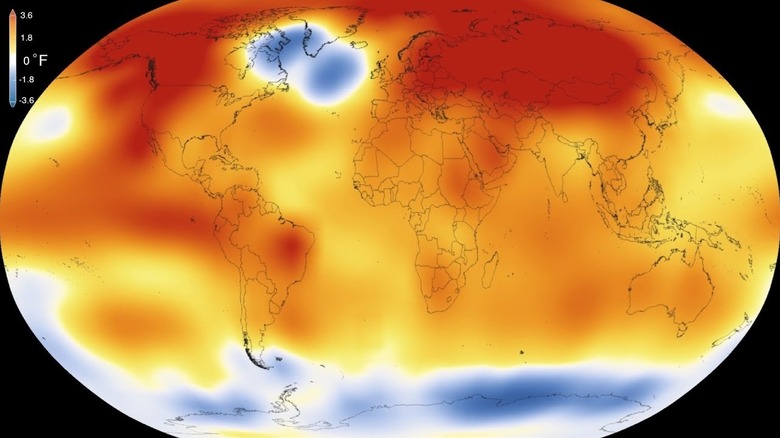Did Biodiesel Fail? Here's What Happened To The Renewable Fuel
Over the last several decades a growing body of evidence has made the problem of global climate change increasingly clear. Humanity's addiction to fossil fuels has changed the composition of our atmosphere and the climate consequences are already here. The question now is what we're going to do about the problem.
Over the last 20 years or so, biodiesel and other biofuels have been touted as a potential replacement or supplement for conventional petroleum based gasoline fuels. In some forms, biodiesel is compatible with a wide range of existing vehicles and offers many of the same benefits of conventional combustion fuels, with a lower environmental impact. Unlike petroleum, which has to be found in hidden pockets underground, pumped up, processed, and distributed all over the world, biodiesel can be produced anywhere you can grow plants.
Not so long ago, people were dreaming of a world filled with cars running on vegetable oil and other biologically derived fuels. More recently, discussions of biodiesel and biofuels have largely faded from public conversation and there's a sense that the days of biodiesel are over. The truth is a little more complicated.
What is biodiesel
Conventional petroleum is a fossil fuel made of ancient plant and animal remains. While people often joke that oil is made of dinosaurs, it's actually mostly ancient plants like algae and zooplankton that have broken down under specific circumstances. Organic matter settles at the bottom of lakes or oceans and gets covered by a layer of sediment. Over millions of years, as additional layers stack on top of it, heat and pressure builds and transforms those dead organisms into petroleum.
Biodiesel, by contrast, begins as used cooking oil, animal oil and fats, tallow, or oils taken directly from crops like rapeseed, corn, soy beans, and others. Scientists at MIT have even experimented with biofuels made from nonfood feedstocks. Those materials then undergo a process called transesterification which transforms them into a fuel.
The transesterification process begins with a feedstock (any of the above-mentioned sources) mixed with alcohol and a catalyst. A chemical reaction breaks the ester bonds in the feedstock's triglycerides and replaces them with alcohol molecules. On the other side of that reaction, you end up with a whole bunch of usable biodiesel and a small amount of glycerol as a byproduct. From there, biodiesel is mixed with conventional petroleum at various ratios or can be used by certain vehicles as is.
[Featured image by Dwight Burdette via Wikimedia Commons | Cropped and scaled | CC BY 3.0]
The invention of biodiesel
Biofuels might be a cutting-edge energy solution but they are also some of the oldest fuels in existence. For thousands of years, people have been using oils derived from plants or animals to light their way. Today, we're using slightly more complicated processes to create even more efficient biofuels.
The diesel engine was invented in 1893 by Rudolf Diesel, and experimentation with vegetable oil fuels began right away. Cheap petroleum fuels wouldn't become available for a decade or so, and interest in vegetable-based diesel fuels was high. A diesel engine operating on peanut oil was presented at the 1900 Paris Exposition but petroleum was on the rise and biofuels were about to take a back seat.
Several times since then, petroleum shortages (caused by wars, legislation, or breakdowns of the supply chain) have driven temporary interest in biofuels. They were used during World War II and in 1938 a Belgian passenger bus ran the route from Brussels to Louvain using biodiesel derived from palm oil. By the late 20th century, fuel shortages combined with growing concerns about the role of automotive exhaust on the environment spurred renewed interest in biofuels. The first plant with the express purpose of producing biodiesel was built in Austria circa 1985, and it's been growing steadily ever since.
The benefits of biodiesel
Since biodiesel is still a combustion fuel and it's used in much the same way as conventional petroleum, it feels counterintuitive that it could be environmentally friendly. You might think it can't possibly be much better for the environment than ordinary diesel, but by many accounts it's considerably better.
Biodiesel burns cleaner, meaning that fewer particulates end up in the air, reducing the risk of heart and lung disease. Additionally, biodiesel has a lower carbon footprint because it is mostly made from plants. Carbon is released when the fuel is burned, just like ordinary fuels, but it's the same carbon the plants pulled from the atmosphere to grow. Rather than pulling sequestered hydrocarbons out of the ground, we're using the same carbon over and over in a renewable cycle.
Another major benefit of biodiesel is that it can be produced domestically. Petroleum has to be retrieved wherever it is and carted all over the planet, whereas feedstock plants can be grown anywhere and biodiesel produced in the places where it's needed, making the whole endeavor more energy efficient. One study found that biodiesel yields 93% more energy than it takes to produce it, whereas ethanol only yields 25%. As a result, the greenhouse gasses and particulate pollution per unit of energy is much lower than petroleum fuels.
Biofuels versus electric vehicles (EVs)
One of the biggest reasons that biodiesel and other biofuels have taken a back seat in recent years is that most of our environmental transportation transition efforts have transitioned to electric vehicles (EVs). A viable replacement for petroleum needs to be available, affordable, and offer approximately the same benefits. It should also be environmentally superior to the gas pump. There's some contention right now over whether biodiesel or EVs are better at meeting those needs, but EVs are pulling ahead.
Modern EVs offer reasonable range, they're available, relatively comparable in price to combustion engine vehicles, and they are more environmentally friendly over the vehicle's lifetime. However, most of the electricity which powers EVs come from power plants that burn fossil fuels and they have some considerable limitations. Battery range works for day-to-day but EV owners struggle on long trips. Charging stations aren't as available as they could be and even rapid charging takes considerably longer than topping off the gas tank.
By contrast, biofuels are compatible with most existing vehicles, especially when mixed with petroleum. Still, biodiesel has its own challenges including land use, challenges with viscosity, and more. Today, EVs are winning the race but advancements in battery and biofuel technologies along with external political and market factors will continue to influence the evolution of transportation.
Lack of biodiesel availability
Whether it's biodiesel or bottled water, if you want consumers to adopt a product it first has to be available to them. In the battle for distribution and adoption, biodiesel is lagging way behind EVs. The U.S. Department of Energy's map of biodiesel fueling stations lists just over 1,400 locations in the United States and they're nowhere near even distributed. Some states have only one biodiesel fueling station, or none, while other states have hundreds.
Biodiesel has moderate distribution along the west coast, largely concentrated in California with a lighter smattering in Oregon and a few stations in Washington state. There are basically no biodiesel stations east of California and west of Nebraska. There are some stations scattered along the east coast but the vast majority are concentrated in the Midwest. In fact, there are more than 1,100 biodiesel fueling stations in Illinois, Iowa, and Minnesota alone.
By contrast, ChargeHub's map of EV charging stations lists more than 25,000 with wide distribution across the country. Regardless of any environmental benefits, when a consumer makes a decision about which vehicle to drive, there are fewer considerations more important than whether they can fuel it up. As it stands, EV owners can drive almost anywhere but the average individual can only reliably use biodiesel in some parts of the country.
Temperature and storage challenges
One of the other challenges to the expansion and adoption of biodiesel is its higher cloud point. The cloud point is the temperature at which paraffins in a fuel cloud and solidify, causing the fuel to thicken. When that happens, fuel doesn't flow through the system as well, filters can clog, and other engine problems can arise. You can see something similar happening when you leave cooking oil or fat out on the counter in the winter and it solidifies.
All fuels have a cloud point but biodiesel clouds at higher temperatures, making it harder to store and use. When small amounts of biodiesel are mixed with petroleum diesel it's not much of a concern because the overall cloud point remains low, but the higher the concentration of biodiesel, the bigger the problem becomes. Gelling is a particular problem for B100, otherwise known as pure biodiesel.
Petroleum diesel only gels when the temperature gets to about 10 or 15 degrees Fahrenheit (-12 to -10 degrees Celsius). By contrast, biodiesel begins to gel at temperatures as high as 60 degrees Fahrenheit (15 degrees Celsius). As a result, considerations have to be made for maintaining a warm enough temperature during operation and storage, particularly when stored in above ground tanks.
The comparatively high (and inconsistent) cost of biodiesel
Historically, the cost of biodiesel has been fairly inconsistent when compared with conventional diesel. Those fluctuating costs are the result of several factors including but not limited to location, operating cost of the fuel plant, the chosen feedstock (tallow, vegetable oil from crops, waste cooking oil, etc.), yield, and the quality of the fuel that's produced.
In addition to inconsistent pricing, biodiesel is often more expensive than conventional diesel. Between 2000 and 2020, the prices of conventional diesel and B20 (a 20/80 mix of biodiesel and diesel) were roughly equivalent, overall. Between 2001 and 2016, B20 was $0.12 more expensive per gallon, on average. Since then, B20 has been about $0.13 cheaper per gallon.
B100 (pure biodiesel), however, has always been more expensive. Since 2005, a gallon of B100 has been an average of $0.80 more expensive per gallon than conventional diesel. It might be better for the environment, but consumers don't usually want to pay a higher price for an unfamiliar alternative.
Challenges of scaling biodiesel
At present, it's just more expensive to grow plants and produce biodiesel than it is to pull oil out of the ground and process it. Relatively small biodiesel operations can be economically sustained with existing supplies of plant and animal oils, but scaling to support a larger proportion of the world's fuel requirement would require a significant investment in infrastructure and some complicated logistics. It's worth noting, though, that this is true of whichever next-generation transportation solution we choose.
In addition to scaling production, we would also need to expand distribution and modify vehicles to handle pure biodiesel. Today, most vehicles can handle a low biodiesel mix like B20 but aren't compatible with B100. Fortunately, the conversion process is relatively simple and affordable. It can involve a hybrid fuel system which uses conventional diesel to start up and keep things warm, while using biodiesel for the bulk of the driving.
Getting to a world of cars powered by biodiesel would require increasing agricultural operations to provide the feedstock, a slight shift in automotive design, additional production plants, and an overhaul of fueling station infrastructure.
Balancing other environmental concerns
In spite of biodiesel's environmental benefits, it's not without its own costs. When taking wider environmental considerations into account, there's some debate over whether biofuels are actually a viable option.
One of the most apparent impacts is an increase in the cost and availability of some foods. Food manufacturers have said that ingredients like soybean oil are sometimes hard to come by because so much is being taken up by the biofuels industry. Additionally, in order to ramp up production, we would have to increase land use for agriculture, which has its own set of environmental costs.
The negative impacts of agriculture on the environment include changes in soil and species distribution due to irrigation, downstream environmental consequences of pesticide use, and pollution from fertilizers. As agricultural waste washes away and flows into waterways it can cause harmful algal blooms and wreak havoc on coastal ecosystems. Not to mention the added pressure it would put on water resources. We also have to take into account the energy expended growing and processing crops into fuel when calculating the overall environmental impact. All of these factors will have to be balanced for biodiesel to make ecological sense.
Did biodiesel fail?
It depends on what you mean by fail. Economically, biodiesel is doing just fine, even if growth is slower than expected. Production and consumption have continued to rise overall from 2001 to the present, but it hasn't succeeded in supplanting or even substantially supplementing conventional fuels.
The progress is slow going but it is happening, and biodiesel is only a small part of the renewable energy revolution. As of 2023, about 28% of all energy consumption in the United States came from petroleum and just 9% came from renewable sources. Of that 9%, about a third came from biofuels, roughly 3% of the total energy mix.
Every little bit helps, but biodiesel and other biofuels have so far not been the great solution we once hoped they might be. All things considered, that's probably okay. After all, we're unlikely to find any single silver bullet to the global climate change problem. Instead, we're going to need a combination of efforts each doing their part to reduce humanity's overall environmental impact.
